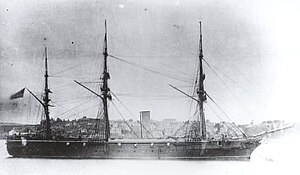 Amethyst at anchor
| |
| History | |
|---|---|
| Name | HMS Amethyst |
| Namesake | Amethyst |
| Builder | Devonport Dockyard |
| Cost | Approximately £77,000 |
| Laid down | 1872 |
| Launched | 19 April 1873 |
| Completed | July 1873 |
| Fate | Sold for scrap, November 1887 |
| General characteristics (as built) | |
| Class and type | Amethyst-class wooden screw corvette |
| Displacement | 1,934 long tons (1,965 t) |
| Tons burthen | 1,405 bm |
| Length | 220 ft (67.1 m) (p/p) |
| Beam | 37 ft (11.3 m) |
| Draught | 18 ft (5.5 m) |
| Installed power | 2,144 ihp (1,599 kW) |
| Propulsion |
|
| Sail plan | Ship rig |
| Speed | 13 knots (24 km/h; 15 mph) |
| Range | 2,060–2,500 nmi (3,820–4,630 km; 2,370–2,880 mi) at 10 knots (19 km/h; 12 mph) |
| Complement | 225 |
| Armament | |
HMS Amethyst was the lead ship of the Amethyst-class corvettes built for the Royal Navy in the early 1870s. She participated in the Third Anglo-Ashanti War in 1873 before serving as the senior officer's ship for the South American side of the South Atlantic. The ship was transferred to the Pacific Station in 1875 and fought in the Battle of Pacocha against the rebellious Peruvian ironclad warship Huáscar two years later. This made her the only British wooden sailing ship ever to fight an armoured opponent.[1] After a lengthy refit, Amethyst again served as the senior officer's ship on the South American station from 1882 to 1885. She was sold for scrap two years later.